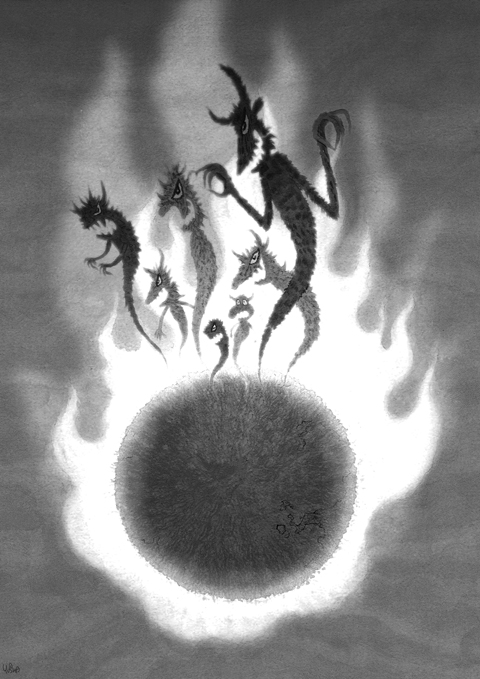The continuous presentation of scary stories about global warming in the popular media makes us unnecessarily frightened. Even worse, it terrifies our kids.
Former US vice president Al Gore famously depicted how a sea-level rise of 6m would almost completely flood Florida, New York, Holland, Bangladesh and Shanghai, even though the UN estimates that sea levels will rise 20 times less than that, and do no such thing.
When confronted with these exaggerations, some of us say that they are for a good cause and surely there is no harm done if the result is that we focus even more on tackling climate change. A similar argument was used when former US president George W. Bush’s administration overstated the terror threat from Iraqi dictator Saddam Hussein.

But this argument is astonishingly wrong. Such exaggerations do plenty of harm. Worrying excessively about global warming means that we worry less about other things, where we could do so much more good. We focus, for example, on global warming’s impact on malaria — which will be to put slightly more people at risk in 100 years — instead of tackling the half-billion people suffering from malaria today with prevention and treatment policies that are much cheaper and dramatically more effective than carbon reduction would be.
Exaggeration also wears out the public’s willingness to tackle global warming. If the planet is doomed, people wonder, why do anything? A record 54 percent of US voters now believe the news media make global warming appear worse than it really is. A majority of people now believe — incorrectly — that global warming is not even caused by humans. In the UK, 40 percent believe that global warming is exaggerated and 60 percent doubt that it is man-made.
But the worst cost of exaggeration, I believe, is the unnecessary alarm that it causes — particularly among children. Recently, I discussed climate change with a group of Danish teenagers. One of them worried that global warming would cause the planet to “explode” — and all the others had similar fears.
In the US, the ABC TV network recently reported that psychologists were starting to see more neuroses in people anxious about climate change. An article in the Washington Post cited nine-year-old Alyssa, who cries about the possibility of mass animal extinctions from global warming.
In her words: “I don’t like global warming because it kills animals, and I like animals.”
From a child who is yet to lose all her baby teeth: “I worry about [global warming] because I don’t want to die.”
The newspaper also reported that parents were searching for “productive” outlets for their eight-year-olds’ obsessions with dying polar bears. They might be better off educating them and letting them know that, contrary to common belief, the global polar bear population has doubled and perhaps even quadrupled over the past half-century, to about 22,000. Despite diminishing — and eventually disappearing — summer Arctic ice, polar bears will not become extinct. After all, in the first part of the current interglacial period, glaciers were almost entirely absent in the northern hemisphere, and the Arctic was probably ice-free for 1,000 years, yet polar bears are still with us.
Another nine-year old showed the Washington Post his drawing of a global warming timeline.
“That’s the Earth now,” Alex says, pointing to a dark shape at the bottom. “And then it’s just starting to fade away.”
Looking up to make sure his mother was following along, he tapped the end of the drawing: “In 20 years, there’s no oxygen.”
Then, to dramatize the point, he collapsed, “dead,” to the floor.
And these are not just two freak stories. In a new survey of 500 US pre-teens, it was found that one in three children between the ages of six and 11 feared that the Earth would not exist when they reach adulthood because of global warming and other environmental threats. An unbelievable one-third of our children believe that they don’t have a future because of scary global warming stories.
We see the same pattern in the UK, where a survey showed that half of young children between the ages of seven and 11 were anxious about the effects of global warming, often losing sleep because of their concern. This is grotesquely harmful.
And let us be honest. This scare was intended. Children believe that global warming will destroy the planet before they grow up because adults are telling them that .
When every prediction about global warming is scarier than the last one, and the scariest predictions — often not backed up by peer-reviewed science — get the most airtime, it is little wonder that children are worried.
Nowhere is this deliberate fearmongering more obvious than in Gore’s Inconvenient Truth, a film that was marketed as “by far the most terrifying film you will ever see.”
Take a look at the trailer for this movie on YouTube. Notice the imagery of chilling, larger-than-life forces evaporating our future. The commentary tells us that this film has “shocked audiences everywhere,” and that “nothing is scarier” than what Gore is about to tell us. Notice how the trailer even includes a nuclear explosion.
The current debate about global warming is clearly harmful. I believe that it is time we demanded that the media stop scaring us and our kids silly. We deserve a more reasoned, more constructive and less frightening dialogue.
Bjorn Lomborg, the director of the Copenhagen Consensus Center, is an adjunct professor at the Copenhagen Business School and author of The Skeptical Environmentalist and Cool It: The Skeptical Environmentalist’s Guide to Global Warming.
COPYRIGHT: PROJECT SYNDICATE

Donald Trump’s return to the White House has offered Taiwan a paradoxical mix of reassurance and risk. Trump’s visceral hostility toward China could reinforce deterrence in the Taiwan Strait. Yet his disdain for alliances and penchant for transactional bargaining threaten to erode what Taiwan needs most: a reliable US commitment. Taiwan’s security depends less on US power than on US reliability, but Trump is undermining the latter. Deterrence without credibility is a hollow shield. Trump’s China policy in his second term has oscillated wildly between confrontation and conciliation. One day, he threatens Beijing with “massive” tariffs and calls China America’s “greatest geopolitical
Chinese Nationalist Party (KMT) Chairwoman Cheng Li-wun (鄭麗文) made the astonishing assertion during an interview with Germany’s Deutsche Welle, published on Friday last week, that Russian President Vladimir Putin is not a dictator. She also essentially absolved Putin of blame for initiating the war in Ukraine. Commentators have since listed the reasons that Cheng’s assertion was not only absurd, but bordered on dangerous. Her claim is certainly absurd to the extent that there is no need to discuss the substance of it: It would be far more useful to assess what drove her to make the point and stick so
The central bank has launched a redesign of the New Taiwan dollar banknotes, prompting questions from Chinese Nationalist Party (KMT) legislators — “Are we not promoting digital payments? Why spend NT$5 billion on a redesign?” Many assume that cash will disappear in the digital age, but they forget that it represents the ultimate trust in the system. Banknotes do not become obsolete, they do not crash, they cannot be frozen and they leave no record of transactions. They remain the cleanest means of exchange in a free society. In a fully digitized world, every purchase, donation and action leaves behind data.
Yesterday, the Chinese Nationalist Party (KMT), once the dominant political party in Taiwan and the historic bearer of Chinese republicanism, officially crowned Cheng Li-wun (鄭麗文) as its chairwoman. A former advocate for Taiwanese independence turned Beijing-leaning firebrand, Cheng represents the KMT’s latest metamorphosis — not toward modernity, moderation or vision, but toward denial, distortion and decline. In an interview with Deutsche Welle that has now gone viral, Cheng declared with an unsettling confidence that Russian President Vladimir Putin is “not a dictator,” but rather a “democratically elected leader.” She went on to lecture the German journalist that Russia had been “democratized